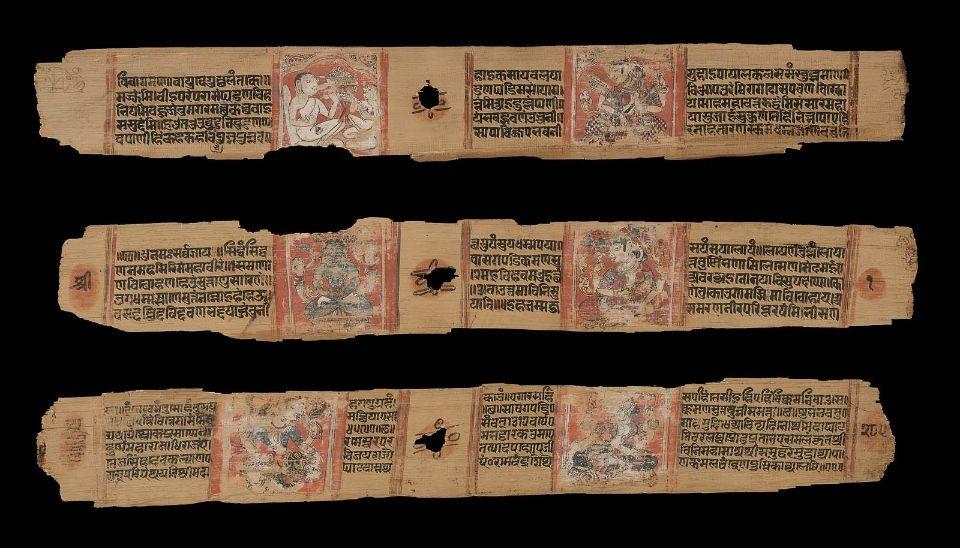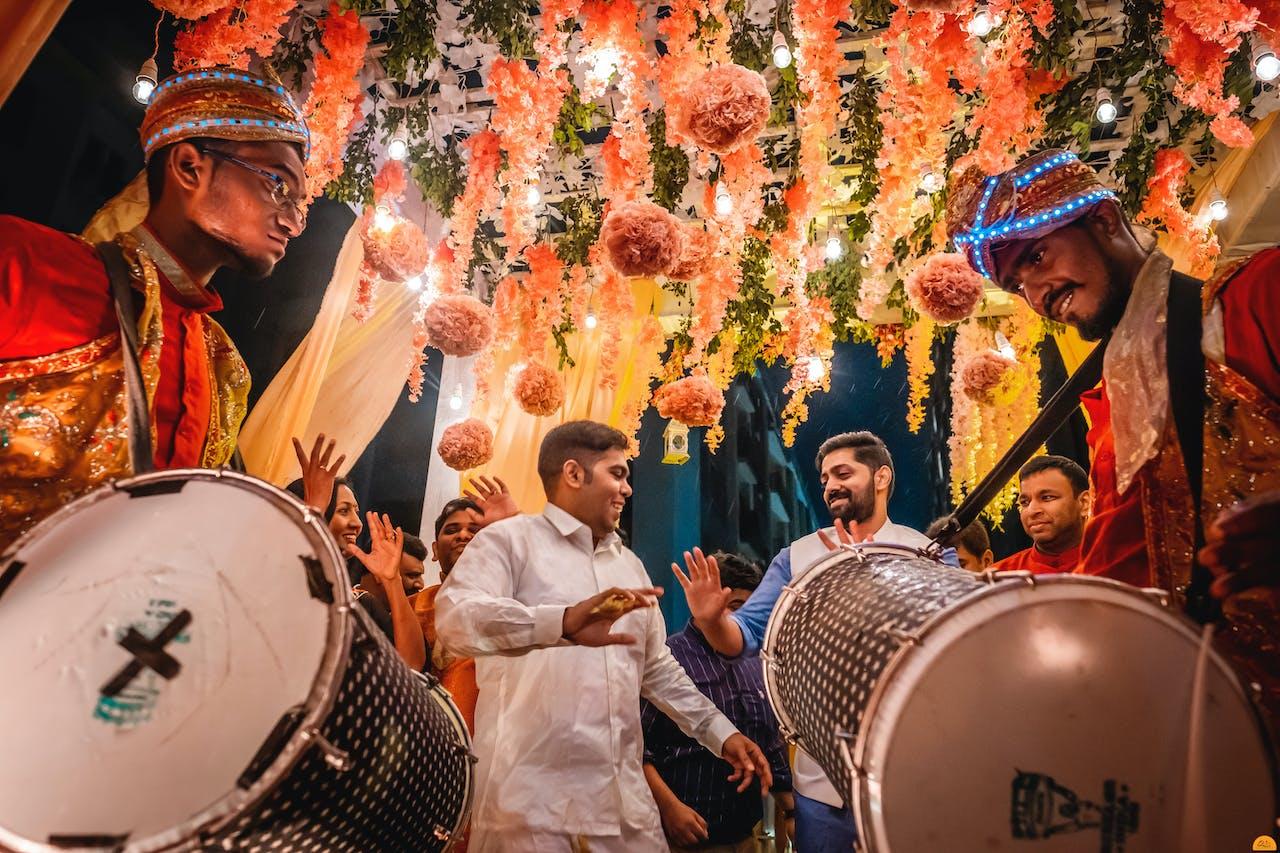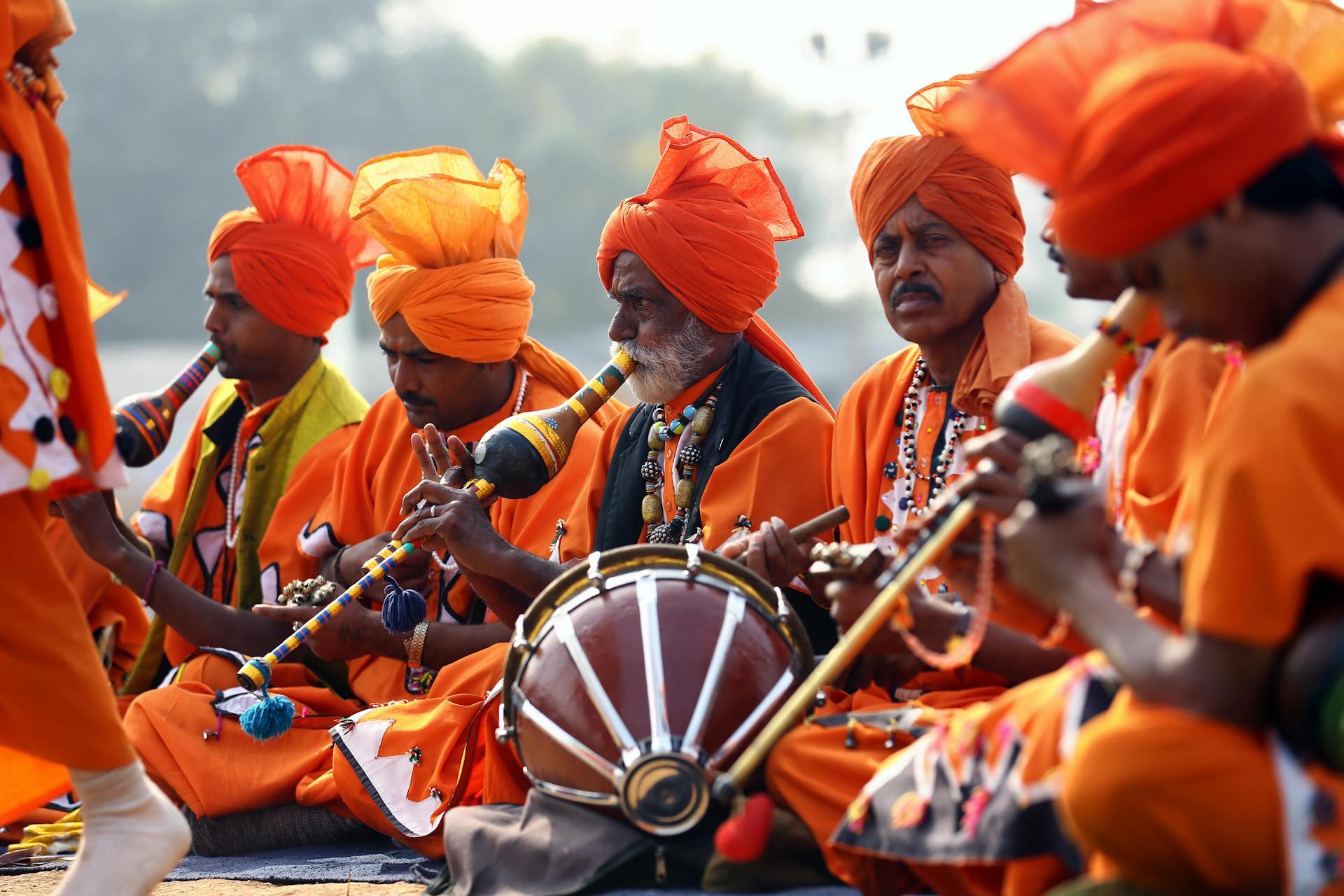The Samaveda (also written as Sama Veda) is one of the four major ancient texts, known as the Vedas, upon which Hinduism is informed.
Among casual learners of Hinduism and its many texts, the Samaveda is one of the lesser-known tomes.
So, what is the Samaveda, why is it important, and what can be learned from studying its pages?

What Is the Samaveda?
Simply put, the Samaveda is the Rigveda set to music.
The scripture, hymns, and mantras contained within the Rigveda are largely present in the Samaveda and are paired with music. It is the earliest example of a structured way of writing music and singing in India.
It was composed third, after the Rigveda and Yajurveda, as a way to help pass the oral tradition to others.
Samaveda As Part of the Vedas
The Vedas are the four major texts studied by Hindus. Besides the Samaveda, the others are known as the Rigveda, the Yajurveda, and the Atharvaveda.
The Samaveda is the shortest of the four, but that does not diminish its importance!
In the Bhagavad Gita, Lord Krishna proclaims, “Of the Vedas, I am Sama,” meaning he has declared it the most important of the Vedas.
The purpose of the Samaveda within the Vedas is to provide an easier way to teach the multitudes of knowledge contained within the Rigveda verbally as well as provide a method of the hymns to be used in rituals and ceremonies. In other words, it’s a liturgical text that was used mainly by Udgatri (“singer priests”).
“Of the Vedas, I am Sama."
Lord Krishna (Gita, 10.22)
Samaveda Meaning
“Sama” has many specific meanings in Sanskrit, and it depends on the context to determine which meaning is being used. In this context, it means “melody,” and as always “veda” means “knowledge.” Another common translation is “gentle song.”
Therefore Samavita means “Knowledge of Melody,” which is why this text is often referred to as “The Book of Songs,” “The Veda of Chants” or even “Yoga of Song.”
The Organization of the Samaveda
Each of the Vedas comprises four parts, or subdivisions: Samhita, Brahmana, Aranyaka, and Upanishads.
For the most part, the Samaveda is known for its Samhita, which is very similar to the Rigveda’s Samhita, but it’s important to know that the two are distinct.
The entirety of this Veda is meant to be sung or listened to, not read, even though it is recorded as a book.
The Samaveda, specifically, also has other components:
- Part I: includes melodies called Gana
- Part II: includes three verses called Archika
- Two Major Upanishads: Chandogya Upanishad and Kena Upanishad
Musical Knowledge in the Samaveda
The hymns in the Samaveda are known as Samans. These Samans are made up of collections of several verses (mantras) grouped. There are 1875 mantras contained in the Samaveda, which each have varying lengths and meters, and contain between 24 and 50 syllables.
The Samaveda helped establish the idea of svara, or sapta svara, which are the indications of notes or tones, depending on the context. The Samaveda also employs sruti tones, or microtones, which are the smallest intervals of change in notes that a human ear can recognize. These musical notations are how the musicality of the written word was conveyed.
Also established in the Samaveda are ganas (versatile melodic patterns); talas (rhythmic patterns); udatta, anudatta, swarita (accentuations like stress and pitch modulation); and even mudras and choreography to be performed with the Samans.
It also distinguishes between Samas meant to be performed in a congregation (gramageya) or recited alone as a type of meditation (aranyageya).
In the ancillary text (Upa Veda) associated with the Samavita, called the Gandharvaveda, information about the rules for setting music and melodies was established, as well as information about playing various instruments.
The Samaveda even mentions the holy instrument played by goddess Saraswati, called the Vina.

History of the Samaveda
The Samaveda was composed after the Rigveda. Its purpose was twofold: first, to set the Rigveda’s wisdom to music because it’s much easier for people to pass on a musical tradition than memorize all the information as a lecture. This is especially important because the Vedas were not written down until around 500 BCE or later; before this, they were almost exclusively a verbal tradition.
Second, the music was also meant as a way to bring the singers and the listeners closer to God and is even believed to alter the state of mind of the performers and witnesses due to the notes and sound.
Who Wrote the Samaveda?
The original Samaveda (and all Vedas) were not written but instead were composed. This is because they were strictly an oral tradition. Disciples were meant to learn directly from a guru, who would teach them the true interpretation of the information as well as the correct pronunciation and musicality, something you can’t get when you study alone.
The actual “author” of the Vedas (and thereby the Samaveda) is not 100% clear. It is believed to have been composed by numerous Rishis over thousands of years as they received divine knowledge during intense meditation. This collection of knowledge was passed on in oral tradition starting around (at the latest) 1500 BCE, though many believe it began much earlier than this.
What is accepted is that a man called Veda Vyasa was the first person to compile the Vedas and transform them from an oral to a written format.
"If 'Rig Veda' is the word, 'Sama Veda' is the song; if 'Rig Veda' is the knowledge, 'Sama Veda' is the realization; if 'Rig Veda' is the wife, 'Sama Veda' is the husband."
David Frawley, Vedic Scholar
The Samaveda Through Time
Over time, the Samaveda was adapted into many different recensions (editions, also called Shakhas), each arranging the material in a culturally specific way, which paved the way for local and familial traditions to grow.
It’s unknown how many official recensions there were originally (according to Sage Patanjali, there were 1000) because only three survive today, which are known as the Kauthuma, Ranayaniya, and Jaiminiya recensions.
In addition to these recensions, localized and familial traditions are still prevalent. So, even though there was originally one correct way to know and perform the Samavita’s Samans, today there are innumerable variations, all of which are respected.
It’s agreed that no one way is better than another. Instead, the Samans are allowed to be modified to suit the people performing it better as needed.

The Samaveda’s Modern Influence
As one of the fundamental Hindu texts, the Samaveda has influenced ancient and therefore modern Indian culture. Many of the musical traditions today are a direct result of this ancient musical system.
Spiritual Significance
The Samaveda’s Samans are still used for rituals and ceremonies in Hinduism.
They are also used as a method for enlightenment. The act of chanting mantras, making specific sounds and frequencies, and hearing the sounds and frequencies, combined with the pranayama and mudra required to perform all create the perfect scene for deep meditation.
It can even be considered Sadhana and is recommended to be part of a Hindu practitioner’s habitual practice.
Musical Significance
The mantras, svara, ganas, talas, udatta, anudatta, and swarita combined with the knowledge of instruments described in the Samaveda Samhita have all influenced many aspects of traditional and modern Indian music.
The Sapta Svara
The basic notes described in the Samaveda and still used today are known as Sa, Ri, Ga, Ma, Pa, Dha, and Ni.
Sruti Tones
In Western music, notes are usually divided into semitones. Sruti tones, or microtones, indicate a smaller difference in pitch between tones than semitones. This is why Indian music contains its hallmark of subtle, lilting, slightly shifting tones, rather than the West’s clean-cut quality.
While the 22 sruti tones weren’t explicitly indicated until The Natyashastra, the existence of them was implied in the Samaveda.
Ragas
The concept of ragas in Indian classical music finds its roots in the musical patterns and chants present in the Samaveda.
Riyaz
The disciplined and ultra-structured nature of riyaz practice, while not directly in the Samaveda, is influenced by the ancient style of teaching the Samans. It can be considered a type of Sadhana. The contents of riyaz also share some teaching with the Upaveda Gandharvaveda.
Bhajan
Many bhajans draw their tunes, melodies, and rhythms from those outlined in the Samaveda. They are also often inspired by the mantras in the Samaveda, although the bhajans are not lifted directly from the text.
Cultural Significance
Modern society is built upon the past. So, every ancient thing has some part to play in the way modern-day society functions. What aspects of today are closely informed by the Samaveda’s creation?
The Natyashastra
Perhaps written (or at least compiled by) Rishi Bharata (aka Bharat Muni), The Natyashastra is the first ever known treatise on performing art and was written sometime between 200 BCE and 200 CE. Much of the information is compiled from all four Vedas, with the musical portion being informed by the Gandharvaveda Upaveda. The Natyashastra continues to have a profound impact on Indian performing arts, and therefore, culture as a whole.
Sound Healing
The Sama Veda deals with music as a way to meditate and be closer to God. This ancient knowledge can easily be dismissed by outsiders as a simple type of prayer.
However, much of ancient Indian knowledge is now under the microscope with new-age tools, and many studies are being done to explore why the ancients had such specific beliefs.
The Gandharvaveda is the science that explains the effect of music and sound on animals, the environment, and the human mind and body.
New studies into sound vibrations show that specific tones create specific sound frequencies, and these frequencies may help to change one’s state of mind or even help alleviate certain ailments. Sound healing is not a new concept, but the science to back up the claims is still in the very early stages.
Could this be the goal of the Samaveda, Gandharvaveda, and original mantras: to create an elevated consciousness and healing through sound?
Contemporary Music
Much of contemporary Indian music is inspired by the techniques and sounds of traditional music, which as we know was first established in the Samaveda.
Cultural Preservation
Practicing the ancient techniques outlined in the Samaveda helps people maintain the traditions performed by their ancestors thousands of years ago. This preservation of culture is important for individuals as well as society as a whole. It’s a fantastic feat to be able to keep such ancient heritage alive!
The Samaveda is an incredible part of history, not just in India or Hinduism, but in the entire world. It’s worth learning more about if you are interested in ancient wisdom or history!
References
- dasa, Radhika Gopinatha. “A Quick Summary of Sama Veda.” LinkedIn, 7 Oct. 2023, www.linkedin.com/pulse/quick-summary-sama-veda-radhika-gopinatha-dasa/.
- Ray, Amit. “The Sama Veda Mantra Chanting: Melody and Rhythms - Sri Amit Ray.” Amit Ray, Compassionate AI Lab, 10 Dec. 2023, amitray.com/the-sama-veda-mantra-chanting-melody-and-rhythms/.
- “Samaveda.” Vedic Heritage Portal, vedicheritage.gov.in/samhitas/samaveda-samhitas/.
- V, Jayaram. “The Samaveda Upanishads.” Hinduwebsite.Com, www.hinduwebsite.com/upanishads/essays/samaveda-upanishads.asp.
- “Veda Vyasa: The Sage Who Compiled the Vedas.” Hindu American Foundation, 21 Sept. 2020, www.hinduamerican.org/blog/veda-vyasa-the-sage-who-compiled-the-vedas.











